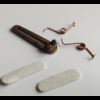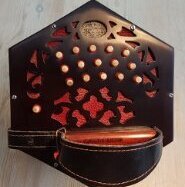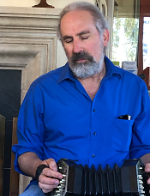
john T
Members-
Posts
20 -
Joined
-
Last visited
Profile Information
-
Gender
Male
Recent Profile Visitors
431 profile views
john T's Achievements

Member (2/6)
-
Refinishing Timber Part Of Lachenal Strap Bracket
john T replied to A2fan's topic in Instrument Construction & Repair
The varnishes used in those times were gum based (Gum Arabic etc) which were disolved in a number of different oils. They are still used in violin making and come in a variety of colours including dark brown. They are by nature very slow drying. Days and not hours per coat. If you aim to use this type of varnish again, you may need to remove the grease that has been absorbed into the wood from years of being touched. Trichlorethylene is good for that, though it is illegal to sell now. Acetone or IPA may do the job but watch out for fumes. They will also lift the grain slightly, so a bit of flour grit paper for rubbing down will be needed. You will need to apply more than 3 or 4 coats, rubbing down in between, and the darker colours in gum varnishes are notoriously difficult for colour 'blobbing'. ie, colour not being evenly spread. The way to build a deep dark colour that keeps its translucency, is with a safron wash onto raw timber, followed by a pale varnish, then darkening coats of red to brown with a final clear top coat. Lot of work for a few bits of wood. But for an instrument like a violin that will sound as good as it looks it's worth it. Kind regards, John T -
Strap Modifications To A Cheap Concertina
john T replied to Bill N's topic in Instrument Construction & Repair
Well done Bill. Lot of imagination gone into that improvisation. A word of caution from a has been reparier/maker. Never use contact cement. I had cellos/fiddles/guitars/concertinas etc come in with repairs done using 'premanent' cement types of adhesive which couldn't be unglued. I know it takes longer for wood glues etc to dry, but the wait can be well worth it if you ever need to restore to the original. Kind regards. John T -
Making new instruments made lining buttons up a doddle. Well, easier. There will always be a rogue, but the method I used was to use a spare bush plate with smaller size holes in it. I would fit this over the buttons and this allowed me to jiggle them into position from side on. Delicately lift off the spare plate. Any that fell sideways - push around a bit till the felt in the button hole made them sit upright. Slip on the spare plate again. When they all stand still when you life it off - bingo. Also, my bush plates could be seperated & were ABS nylon, which meant they could be screwed over and over. Sometimes you can fit the bush plate seperately, put the facia back on & rescrew the plate to it. Only if they were built like that of course. Hope that helps. Kind regards, John Timpany.
-
Thanks very much Jake. Kind words heal many wounds. Kind regards, John T.
-
Thanks Dan, and sorry not to have replied sooner. No-one taught me any aspect of concertina manufacture. I started by tuning them using a tuning fork (one only in 'C') and tuning 5ths to 2 beats per sec out so I culd work up through all the octaves. One day a friend asked me to make an appalachian dulcimer & a spice rack - (I never did tune that!) and his gift in return was a hand made electronic tuning system. It sat on my bench for a good six months out of sheer bloody mindedness to continuing tuning traditionally, but of course one day I set it up, and concertina tuning turned from being a sad back burner job that I mostly avoided, to being the most profitable and by far the most interesting. Most of the instruments that arrived in my workshop needed more than just tuning. Pads were broken and worn, valves missing, springs not working or broken etc, and one by one I found ways of getting the right materials to make them. The bellows were a particularly difficult adventure, and I went down the new route of using ABS nylon for the jig, which had to collapse after the bellows were assembled, since ABS can be washed clean of all glue after without warping. All initial developments were extremely expensive and had to be right first time. I couldn't experiment with jigs, I just had to get them right first time. I based most of what I built (as I did with violins and especially bows) on the best makers that I could find, which didn't mean mine came out just as good. They came out different, but in aiming high, mostly things were better than not aiming at all. I determined on a set of 9 reed frames and reeds, which then formed the basis of the reed pan structure. Once reed frame sizes were settled, I then knew the size or the frame slot at the surface, I could calculate the 'break out' bevelling of the frame during pressing, and could then work out the angle of the cutting blade on the router for routing frame slots. I got one or two wrong on the original, but by packing the sides of the slot either side with slivers of sycamore (the wood I used for the pans) It worked out well. I used sycamore because of its stability, workability and resonance. (Maple, a close cousin is used for violin backs & sides) I did seem to soften the tone. I used pear for the sides of the lever & button housings which I stained black. Marine ply was used for the base of these housings, since it was very stable & I had seen so many bases warped and it didn't affect tone as I found in repair work. The big advantage of repair is that it is an area where you can experiment and replace if it doesn't work out. The sides of the bellows frames were also sycamore, but I did try beech too which was heavier, harder to work, but made the overall 'feel' of the instrument weightier but yet more easily played. The leather on the bellows and valves was pneumatic leather, which was used originally and more popularly for church organ pheumatic valve sides. (I had repaired a couple of organs). What was the trickiest job, was once the stutting was glued in place on the outer side of the reed pans. It was very irregular and had to be sanded flat. Well, sanded so that it married up with the under side of the button & lever housing. From my experience as an engineer, I knew that hand sanding would 'dome' this strutting, so I devised a sanding bed that was marginally cameo as opposed to intaglio so that sanding resulted in flat strutting. The leather I used on top of the struts was an inner calf skin cut so it was 'sueded' on both sides and under pressure gave a good seal. I used this inner leather calf for the insides of the bellows frames, and at the bottom of the pads too. As long as it was under pressure, it didn't leak. I had tried pneumatic on the pads, but astonishingly it leaked very slightly. I used artist card for the top of the pad, moth proof felt in between and then leather. The glues used were mostly modern woodworking (upv?) adhesives, but on some occassions rabbit skin glue softened in a glue kettle. I hope that covers your question. Kind regards - John T
-
Ahhh, well, the secret has to come out I suppose. I used a router, unlike any other end-plates at the time. I cut two templates from brass and used these to guide a small router bit around each 'fretted' end-plate. You'll notice that there aren't any sharp corners Rod, since routers don't do sharp corners. So long as I kept a good flow of suds (lubricant) I didn't burn out too many router bits. It was one of the ways I was trying to keep costs down. From the 'fretted' mild steel plate, I then stamped the edges with a bolster chisel to create the lip, filed off any burring with swiss files, stamped on the name, then burnished with a flap wheel. When the final end-plate had a high steel polished look, I took it for plating. I think (I am not sure of the coats) that it was plated with nickel first, then chrome. It meant I was able to produce an end plate in about 30 mins, and polished ready to plate in an hour. If you look inside the action box, you'll see that the levers were made from thick brass wire (I think I made most of them like that) and where I needed to pivot the lever I stamped it under a fly press and drilled a hole in it, then threaded one end for the pad. This method also saved a lot of time, but it wasn't unique. Regarding etching 'fret' work, I honestly have no idea. I think it may be pretty expensive to do, since a lot of acid might be needed. I really don't know. Sorry. I do know that some makers would use a CNC router to cut the basic 'fretting' shape out and cut the corners in by hand so that it would appear to have all been done manually. But I am no expert on concertinas. There are people on this site with phenominal knowledge, and I expect one of them can answer that question better than I. I have a feeling too, that with thick metal the etching might 'undercut' since it would have to be in the bath quite a time. But I am guessing only Rod. I think I looked at the possiblitliy, but can't remember why I rejected it. Kind regards - John Timpany.
-
Mike, I think he may be pulling your leg. (Unless he was using a machine of course) Stainless steel is notorious for being hard and difficult to work. When I hand fretted my ends, each N/S end would take a day - a good 8 hours each one. It isn't just the drilling & sawing, it's the fine filing too. If I had to do the same job with stainless - I wouldn't bother waking up! Kind regards - John Timpany. And I must say guys, your concertina ends are beautifull. Very well done indeed.
-
Choosing Wood For A Jones Repair
john T replied to Geraghty's topic in Instrument Construction & Repair
Just a quite note to put your mind to rest... Wood darkens with age and (in particular) enviroment, and sometimes repairs to wooden ends howl at you since the new wood is so obvious, but there is no choice unless you can find aged timber for repairs. Some makers/repairs carry parts from instruments that were beyond repair especially for this purpose. They might be worth a try. Kind regards - John Timpany. -
Fixing Rattle/buzz On Rochelle?
john T replied to tmborden's topic in Instrument Construction & Repair
My appologies. You are quite right. It's been a long time since I saw this type of instrument. Kind regards - John Timpany. -
Stevejay - thank you very much indeed. In fact I would like to thank all of you. Shire concertinas left a cloud over my head and I must admit it wasn't easy for me to post here. It was one of the reasons why I never went back to playing music professionally, since I felt like a pariah from the collapse of the business. Thank you very much. Kind regards - John Timpany
-
David's suggestions are very sound. If I had a machine for repair that had a stubborn warp on the action box, I would remove all the leather from the strutting on the reed pan and marry it to the action box by putting a sheet of fine grit sandpaper on the warped surface & slowly rubbing them together using a small diameter circular motion. (Take the reeds out first and repeatedly check the fit) When they match well enough, clear out any dust from the valves, fit new leather strips to the struts (which is a really easy job), pack the small triangular supports if it is needed (new leather is usually sufficient) and reassemble. One end would probably take about an hour. Hope this helps. Kind regards - John Timpany.
-
Small correction to my manufacturing note under Shire Concertinas. The reed pans require 6 router templates per type of instrument. For each side there are two frame slot cutting templates (upper and lower) and one 'through slot' template for the reed vibration space & air passage. Sorry for the mistake. Kind regards - John Timpany.
-
That's the book Dave. It's been out of print for a long time now. There were some web sites (predominantly USA sites) selling extant copies, but I don't know how much for, but if you consider that our records which once sold for £7.50 or so are now selling at £100+, then it might just be worth more than you paid. I don't blame you for choosing the concertina, the notes are much easier to find. I still prefer fiddle though. I learnt from the late Arnold Woodley, who learnt from Jinky Wells, and after Jinky died assumed his role as Bampton Morris (A team I think) musician. I spent hours upon hours watching, listening and copying him, which is how it used to be passed down. The book came about from notating his bow movements. Kind regards - John Timpany.
-
As I still see it Dirge, I had a choice. I don't lay blame at anyone's doorstep except my own. I was doing very well at the time but when a high developement loan was suggested, I saw the possibility that I might be able to setup a simple manufacturing business in much the same way that fiddles were produced in Mittenwald in the late 19th early 20th Cent which provided low cost, hand-made, high quality instruments. Perhaps I became too ambitious. I most certainly had no idea as to the pitfalls of banks & finance! I learnt a lot from it, but from a personal point of view I paid a high price for the lessons. I did write to my MP later about the bank's solicitors coming after my house like frenzy feeding sharks, but I got the standard secretarial response. Loosing everything is no big deal when you don't have much. Kind regards - John Timpany.
-
Tuning - Another Idea For A "jig"
john T replied to Simon H's topic in Instrument Construction & Repair
I used an old set of concertina bellows, blanked off at one end, and the other bolted to the underside of the bench. The bench had a hole in it, and ontop of the bench over the hole, I fitted my jig. That way I had both hands free and could push the bellows up with my knee. The reed spoke on the downward pull of the bellows of course. It also gave the right amount of 'pull' of air. Too much can overblow a reed and leave it out of tune. Well done for the inventiveness. Kind regards - John Timpany.




